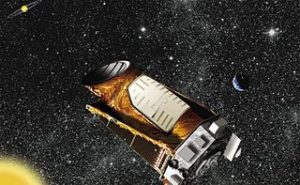While we’re on the subject of meteors, what have meteors got to do with meteorology? It turns out that the link between meteors and meteorology is a Greek word, meteoron, that refers to things in the air, or sky—what today we would call atmospheric phenomena. Clouds, lightning, rain, storms, wind: these are all features of the sublunary sphere (below the moon), where things were changeable and imperfect, in contrast to the unchanging perfection beyond it. Meteors were also thought to be purely atmospheric.
Meteors are in fact an atmospheric phenomenon, but, contrary to Greek cosmology, they originate much further out. However, it didn’t make sense at the time that something so fleeting could come from the supposedly perfect and unchanging realms beyond the sublunary sphere. The name meteorology for the study of the other atmospheric phenomena stuck, however. Meteorologists do talk about hydrometeors, but they have nothing to do with the interplanetary kind of meteor; they’re water droplets or other types of precipitation that form in the atmosphere by condensation.
The astronomy–astrology link is also interesting. When I was an undergrad studying astronomy, I was startled and mildly annoyed at how many people got the two confused. Sometimes it was just a slip of the tongue; the words are quite similar. Sometimes the confusion was deeper. One time, for example when I was reading a copy of Astronomy magazine, a co-worker asked me, in all seriousness, “Do you really believe that stuff?” After various similar discussions, I became somewhat sensitive on this point.
However, at one time astrology was astronomy, the study of the heavens. There were essentially two types of astrology: natural and judicial. Natural astrology concerned itself with figuring out the tides and the seasons and similar natural phenomena that result from the Earth’s interaction with other bodies in the solar system. Eventually these pursuits segued into what we now call astronomy. Judicial astrology involved more speculative investigations of how celestial events affected humans directly, e.g., linking their personality to the positions of the planets when they were born, or the course of a disease to the influence of the moon or planets. The word judicial refers to the fact that astrologers made judgments about what they thought was going on, which differed from the more numerical and observational nature of natural astrology.

Today we have better explanations for personalities and diseases, and astrology is recognized as unfounded nonsense. However, it was only within the last few hundred years that the astronomy–astrology boundary that we know today became firm. Kepler, who figured out that the planets have elliptical orbits and formulated three laws describing planetary motion, also earned money by casting horoscopes. Interestingly, he has both a scientific satellite and a school of astrology named after him: the Kepler mission to search for extrasolar planets, and Kepler College, which offers online training in astrology.
More recently, astrophysics became recognized as separate from astronomy. Before the dazzling revolution in astronomy brought about by the introduction of photography and spectroscopy, astronomers could study the positions and motions of heavenly bodies but not their compositions or other characteristics, which severely limited how much they could figure out about their evolution. With spectroscopy, astronomers could determine a star’s composition and temperature, how fast it was rotating, and other features—stellar spectra reveal an astonishing amount of information!—and also begin to categorize stars and figure out how they formed and aged. Thus was born astrophysics, which focuses on the chemical and physical properties of stars, galaxies, and other objects. So there you have it: astrology to astronomy plus astrophysics by a series of interesting transitions.
Learn more:
- How astrophysics became differentiated from astronomy at In the Dark